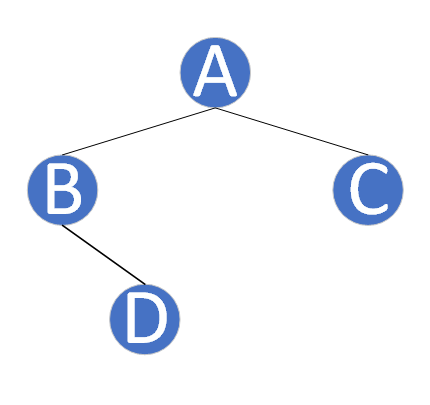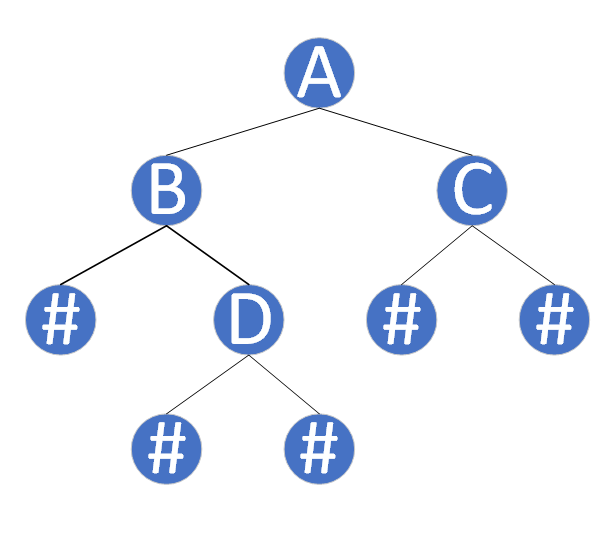本篇文章将介绍二叉树的常见构造方法,总体涵盖控制台输入字符串构造和根据字符串构造,两者构造的区别是,前者构造序列需要从控制台输入,后者构造序列可以通过现有字符串直接构造;并且通过递归与迭代两种思路进行构造,我们将先通过递归进行构造,然后将递归转化为迭代,如果不知道如何将递归转化为迭代,请参看文章数据结构——递归与非递归。
假设有如下一颗二叉树:

我们可以根据图示二叉树写出他的前序序列为:ABDC。如果反过来,已知前序序列ABDC,我们能不能根据前序序列画出二叉树呢,答案是不能。我们可以将二叉树稍微改造一下,用#代表空结点,改造结果如下所示:

我们写出改造后的二叉树的前序序列:AB#D##C##。现在我们就可以根据改造后的二叉树前序序列唯一地构造二叉树了。
控制台递归构造,就是将前序序列通过控制台输入的方式逐一录入,然后将录入的前序序列通过递归进行构造。我们将二叉树采用二叉链表的方式进行存储,即结点包含三部分,数据域,左孩子和右孩子。如下图所示:

给出二叉树结点的定义,代码如下:
1 /* 二叉树结点 */ 2 template <typename DataType> 3 struct BiNode 4 { 5 DataType data; 6 BiNode<DataType>* lChild; 7 BiNode<DataType>* rChild; 8 };
我们给出二叉树的定义,代码如下:
1 template <typename DataType> 2 class BiTree 3 { 4 public: 5 BiTree() { root = create(); } // 构造函数 6 ~BiTree(); // 析构函数 7 private: 8 BiNode<DataType>* create(); // 控制台递归构造二叉树 9 BiNode<DataType>* root; // 二叉树根结点 10 };
接下来我们实现控制台递归构造二叉树的方法 BiNode<DataType>* create();代码如下:
1 template <typename DataType> 2 BiNode<DataType>* BiTree<DataType>::create() 3 { 4 BiNode<DataType>* bt; 5 char ch; 6 std::cin >> ch; // 控制台录入 7 if ('#' == ch) 8 { 9 bt = nullptr; 10 } 11 else 12 { 13 bt = new BiNode<DataType>; 14 bt->data = ch; 15 bt->lChild = create(); // 递归构造左子树 16 bt->rChild = create(); // 递归构造右子树 17 } 18 return bt; 19 }
字符串递归构造,就是传入一个字符串前序序列作为参数,然后进行递归构造二叉树。我们依旧采用二叉链表的方式,本文二叉树的存储结构我们一直采用二叉链表的方式。
修改二叉树的定义如下:
1 template <typename DataType> 2 class BiTree 3 { 4 public: 5 BiTree() { root = create(); } 6 BiTree(std::string tree, int index) { root = create(tree, index); } 7 ~BiTree(); 8 private: 9 BiNode<DataType>* create(); 10 BiNode<DataType>* create(std::string tree, int& index); 11 BiNode<DataType>* root; // 二叉树根节点 12 };
接下来我们实现字符串递归构造二叉树的方法 BiNode<DataType>* create(std::string tree, int& index);代码如下:
1 template <typename DataType> 2 BiNode<DataType>* BiTree<DataType>::create(std::string tree, int& index) 3 { 4 BiNode<DataType>* bt; 5 char ch; 6 ch = tree[index]; 7 if ('#' == ch) 8 { 9 bt = nullptr; 10 } 11 else 12 { 13 bt = new BiNode<DataType>; 14 bt->data = ch; 15 bt->lChild = create(tree, ++index); 16 bt->rChild = create(tree, ++index); 17 } 18 return bt; 19 }
我们将字符串递归构造改写成字符串迭代构造。
修改二叉树定义, 代码如下:
1 template <typename DataType> 2 class BiTree 3 { 4 public: 5 BiTree() { root = create(); } 6 BiTree(std::string tree, int index) { root = create(tree, index); } 7 BiTree(std::string tree) { createIter(tree, 0); } 8 ~BiTree(); 9 private: 10 BiNode<DataType>* create(); 11 BiNode<DataType>* create(std::string tree, int& index); 12 void createIter(std::string tree, int index); 13 BiNode<DataType>* root; 14 };
接下来我们实现字符串迭代构造二叉树的方法 void createIter(std::string tree, int index);代码如下:
1 template <typename DataType> 2 void BiTree<DataType>::createIter(std::string tree, int index) 3 { 4 root = new BiNode<DataType>; 5 root->data = '*'; 6 BiNode<DataType>* bt = root; 7 BiNode<DataType>* stack[20]; 8 int top = -1; // 栈顶指针 9 10 while ('#' != tree[index] || -1 != top) 11 { 12 while ('#' != tree[index]) 13 { 14 if (bt == nullptr || '*' != bt->data) 15 { 16 bt = new BiNode<DataType>; 17 } 18 bt->data = tree[index]; 19 stack[++top] = bt; // 保存现场 20 ++index; // 修改局部变量 21 if ('#' == tree[index]) 22 { 23 bt->lChild = nullptr; 24 } 25 else { 26 bt->lChild = new BiNode<DataType>; 27 bt = bt->lChild; 28 bt->data = '*'; 29 } 30 } 31 32 bt = stack[top--]; // 恢复现场 33 ++index; // 修改局部变量 34 if ('#' != tree[index]) 35 { 36 bt->rChild = new BiNode<DataType>; 37 bt = bt->rChild; 38 bt->data = '*'; 39 } 40 else 41 { 42 bt->rChild = nullptr; 43 } 44 } 45 }
我们可以根据前序序列和中序序列唯一地确定二叉树,确定方法请参考文献2。
修改二叉树定义, 代码如下:
1 template <typename DataType> 2 class BiTree 3 { 4 public: 5 BiTree() { root = create(); } 6 BiTree(std::string tree, int index) { root = create(tree, index); } 7 BiTree(std::string tree) { createIter(tree, 0); } 8 BiTree(std::string preOrder, std::string inOrder, int n) { root = create(preOrder, inOrder, n); } 9 ~BiTree(); 10 private: 11 BiNode<DataType>* create(); 12 BiNode<DataType>* create(std::string tree, int& index); 13 void createIter(std::string tree, int index); 14 BiNode<DataType>* create(std::string preOrder, std::string inOrder, int length); 15 16 BiNode<DataType>* root; 17 };
接下来我们实现字符串递归构造二叉树的方法BiNode<DataType>* create(std::string preOrder, std::string inOrder, int length);代码如下:
1 template <typename DataType> 2 BiNode<DataType>* BiTree<DataType>::create(std::string preOrder, std::string inOrder, int n) 3 { 4 BiNode<DataType>* bt; 5 6 if (0 == n) 7 { 8 bt = nullptr; 9 } 10 else 11 { 12 bt = new BiNode<DataType>; 13 bt->data = preOrder[0]; 14 int n = inOrder.find(preOrder[0], 0); 15 std::string lPreOrder = preOrder.substr(1, n); 16 std::string lInOrder = inOrder.substr(0, n); 17 std::string rPreOrder = preOrder.substr(n + 1, preOrder.size() - 1 - n); 18 std::string rInOrder = inOrder.substr(n + 1, inOrder.size() - 1 - n); 19 bt->lChild = create(lPreOrder, lInOrder, n); 20 bt->rChild = create(rPreOrder, rInOrder, inOrder.size() - 1 - n); 21 } 22 23 return bt; 24 }
1、[二叉树地建立方法总结](https://www.cnblogs.com/llhthinker/p/4906631.html)
2、数据结构——从概念到C++实现(第三版) 王红梅、王慧、王新颖 编著